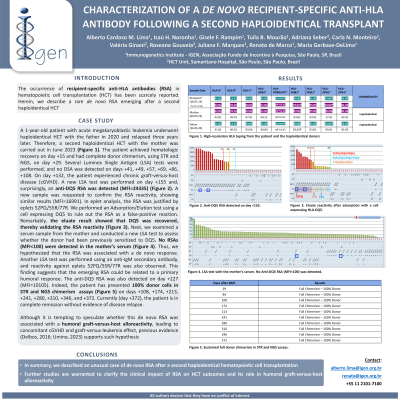Back

CHARACTERIZATION OF A DE NOVO RECIPIENT-SPECIFIC ANTI-HLA ANTIBODY FOLLOWING A SECOND HAPLOIDENTICAL TRANSPLANT
(P311) Characterization of a De Novo recipient-specific anti-hla antibody following a second haploidentical transplant
Location: Platinum Ballroom

Poster Presenter(s)
Body: The occurrence of recipient-specific anti-HLA antibodies (RSA) in hematopoietic cell transplantation (HCT) has been scarcely reported. Herein, we describe a rare de novo RSA emerging after a second haploidentical HCT. A 1-year-old patient with acute megakaryoblastic leukemia underwent haploidentical HCT with the father in 2020 and relapsed three years later. Therefore, a second haploidentical HCT with the mother was carried out in June 2023. The patient achieved hematologic recovery on day +15 and had complete donor chimerism, using STR and NGS, on day +29. Several Luminex Single Antigen (LSA) tests were performed, and no DSA was detected. On day +132, the patient experienced chronic graft-versus-host disease (cGVHD). A new LSA test was performed on day +155 and, surprisingly, an anti-DQ5 RSA was detected (MFI=24335) (Figure 1A). A new sample was requested to confirm the RSA reactivity, showing similar results (MFI=16991). In eplet analysis, the RSA was justified by eplets 52PQ/55R/77R. We performed an adsorption/elution test using a cell expressing DQ5 to rule out the RSA as a false-positive reaction. Remarkably, the eluate result showed that DQ5 was recovered, thereby validating the RSA reactivity (Figure 1B). Next, we examined a serum sample from the mother and conducted a new LSA test to assess whether the donor had been sensitized to DQ5. No RSAs (MFI <100) were detected in the mother's serum. Thus, we hypothesized that the RSA was associated with a de novo response. Another LSA test was performed using an anti-IgM secondary antibody, and reactivity against DQ5 was also observed. This finding suggests that the emerging RSA could be related to a primary humoral response. The anti-DQ5 RSA was also detected on day +227 (MFI=10105). Indeed, the patient presented 100% donor cells in STR and NGS chimerism assays on all post-HCT samples. Currently (day +312), the patient is in complete remission without evidence of disease relapse. Although it is tempting to speculate whether this de novo RSA was associated with a humoral graft-versus-host alloreactivity, leading to cGVHD and graft-versus-leukemia effect, previous evidence (Delbos, 2016; Umino, 2023) supports such hypothesis.
Conclusion: In summary, we described an unusual case of de novo RSA after a second haploidentical HCT. Further studies are warranted to clarify the clinical impact of RSA on HCT outcomes.
Conclusion: In summary, we described an unusual case of de novo RSA after a second haploidentical HCT. Further studies are warranted to clarify the clinical impact of RSA on HCT outcomes.

